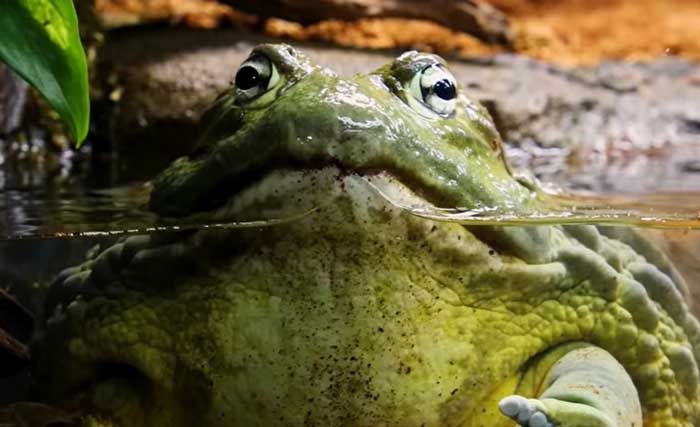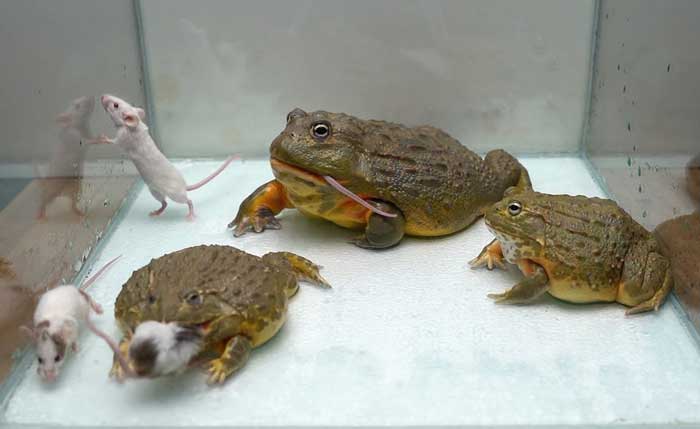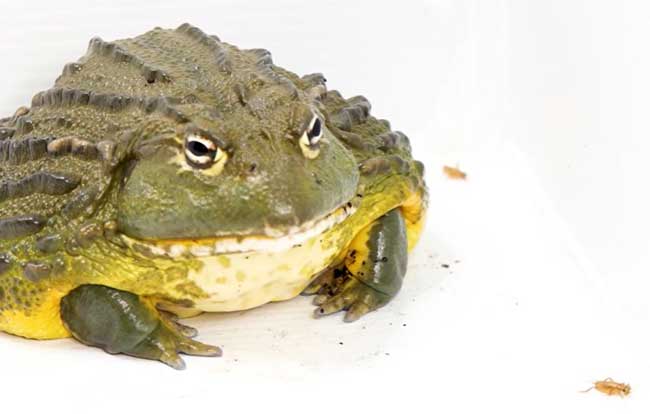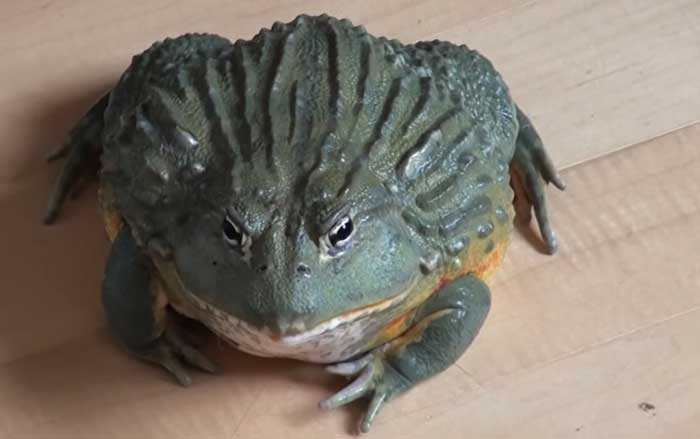African bullfrogs are not your typical pets. They are carnivorous predators in nature. So, they need special treatment in captivity. But don’t worry because that’s exactly what I’m here to help you with.
Now, how do you take care of the African bullfrog as pets? Here are some tips on their care, diet, tank setup, temp, etc.
- Provide a big enclosure with both land and shallow water areas.
- Maintain a temperature range of 75°-85°F and a 50-70% humidity level.
- Feed a varied carnivorous diet.
- Feeding as much food as the frog takes about 15 minutes to eat.
- Serve food 1-2 times per week for adults.
There’s more about an African Bullfrog. Are you interested to know? Find out in our full guide below.
African Bullfrog As Pets: The Ideal Habitat You Need To Maintain

African bullfrogs are not very difficult to care for as long as you understand their natural behavior and needs.
Here are some important aspects of African bullfrog care.
The Proper Tank Setup

African bullfrogs spend most of their time on land. According to a 2015 study, they burrow into the soil or hide under rocks for years. They prefer shallow, temporary pools that form during the rainy season.
- Therefore, the ideal habitat for an African bullfrog is a large, spacious enclosure that mimics their natural environment.
- It must have a dry land area and a small water area.
- The enclosure should be at least 20 gallons in volume for a single frog. This volume should be larger if you plan to house more than one.
- The land area should have a substrate that allows the frog to dig and burrow, such as peat moss, coco fiber, or organic potting soil.
- Also, the tank should have a smooth, easy-to-clean substrate, such as gravel or sand.
- The water area should be shallow, no more than 4 inches deep. The water should be dechlorinated and filtered. You also have to change it every 15 days to keep it clean and fresh.
You can also add some live or artificial plants, rocks, driftwood, and other decorations. These provide hiding places and enrichment for your frog.
Ideal Temperature And Humidity For An African Bullfrog Tank

The ideal temperature and humidity for an African bullfrog tank should be similar to its natural habitat.
- You should maintain a temperature range of 75-85°F (24-29°C) in the tank and a humidity level of 67-80%.
- You may use a heat lamp, a heat mat, or a ceramic heater to provide heat.
- Use a spray bottle or a humidifier to provide moisture.
- You should also create a temperature gradient in the tank by placing the heat source on one side and leaving the other side cooler. This way, your frog can choose the temperature that suits it best and regulate its body temperature.
- Furthermore, you should also provide a day and night cycle for your frog. You can do this by turning on the light for 12 hours and turning it off for 12 hours.
African Bullfrog’s Diet: The Proper Diet Guide
African bullfrogs are carnivorous animals. As depicted in the 1950 book by Arthur Loveridge, they eat other animals as their main source of food. They have a large appetite and a wide range of prey. So, they will eat anything that fits in their mouth.

Here are some important African bullfrog diet facts you should know:
What Do African Bullfrogs Eat (And What Can You Feed)?
In the wild, African bullfrogs eat a variety of prey, such as:
- Insects
- Worms
- Snails
- Spiders
- Scorpions
- Centipedes
- Millipedes
- Crustaceans
- Fish
- Frogs
- Lizards
- Snakes
- Rodents
- Birds
- Small mammals (newborn mice, rodents, etc).

In captivity, you can feed your African bullfrog a similar diet. You can feed live or frozen-thawed items that are appropriate for their size. You can also feed commercially available amphibian foods too.
But, if you want to feed naturally, some of the common foods that you can offer are:
1. Insects: You can feed your frog insects such as:
- Crickets
- Locusts
- Grasshoppers
- Cockroaches
- Mealworms
- Waxworms
- Earthworms
- Superworms

2. Fish: These are another good source of protein and omega-3 fatty acids for African bullfrogs. They can also help keep their teeth clean and sharp. You can feed your frogfish such as:
- Goldfish
- Guppies
- Minnows
- Feeder fish
3. Rodents: A 2014 peer-reviewed study tells that African Bullfrogs eat rodents too. Rodents are a high-calorie and high-fat food for African bullfrogs. So, you can feed your frog rodents such as mice, rats, hamsters, or gerbils.
However, you should only feed your frog rodents that are pre-killed, frozen, and thawed.
Here’s a video of how an African Bullfrog devours a rodent:
4. Reptiles: These are a natural and occasional food for African bullfrogs. You can feed your frog reptiles, such as lizards, geckos, skinks, or snakes.
Again, you should only feed your frog reptiles that are pre-killed, frozen, and thawed.
How Much And How Often Should I Feed My African Bullfrog?
As a general rule, you should feed your frog as much as it can eat in 15 minutes. Then, remove any leftover food after that.

Here is a table that shows the approximate feeding schedule for African bullfrogs based on their age and size:
| Age/Size | Feeding Frequency | Food Type/Size |
|---|---|---|
| Hatchling | Daily | Small insects (pinhead crickets, fruit flies, etc.) |
| Juvenile | Every 2 days | Medium insects (crickets, locusts, mealworms, etc.) |
| Adult | Once or twice a week | Large insects, fish, rodents, reptiles, birds |
Note: African bullfrogs may go through periods of fasting or hibernation. During these periods, they may stop eating, burrow into the substrate, and become inactive and dormant.
This is a natural and normal behavior for these frogs. You should not force them to eat or disturb them during this time.
What Are Some Healthy Homemade Snacks For African Bullfrogs?
Besides the commercial and live foods, you can also make some healthy homemade snacks for your African bullfrog. Here are some examples:

1. Boiled eggs
Boil an egg for about 10 minutes, peel it, and cut it into small pieces. You can then offer a piece to your frog using a pair of tweezers or a spoon.
2. Cooked chicken
Cook a piece of chicken breast without any seasoning or oil. Cut it into small pieces. Offer one or two spoonfuls to your frog. Avoid offering the skin and bones.
3. Fruits and vegetables
Chop up some fruits and vegetables, such as apples, bananas, grapes, carrots, cucumbers, or lettuce. Offer half a cup of them to your frog using a pair of spoons.
FAQs
Here are some frequently asked queries about African bullfrogs that you might want to know:
African bullfrogs are not very compatible with other animals. They are territorial, aggressive, and predatory. So, they may view other animals as rivals, threats, or food and attack or eat them. Therefore, I don’t recommend keeping any neighbor animals in an African bullfrog’s tank.
Tadpoles of the African bullfrog require a diverse diet consisting of live or frozen prey, including fish, mice, crickets, earthworms, and other frogs. Broccoli, lettuce, spinach, and zucchini are among the veggies they can consume.
African bullfrogs lay thousands of eggs, which hatch into tadpoles within a few days. The tadpoles grow and metamorphose into froglets within a few weeks. Finally, the froglets then disperse into the land and mature into adults within a year.
Final Words
African bullfrogs can make rewarding pets for dedicated owners. They have some special requirements. You have to house them in a large tank with dry land and shallow water sections. Keep the temperature within 75-85°F with heat lamps or mats.
Maintain humidity around 50-70% using misters or humidifiers. You’ll also need to give 12 hours of light and 12 hours of darkness daily. Handle minimally and gently using gloves. Lastly, you must offer a diverse carnivorous diet, including insects, worms, fish, rodents and reptiles.

Tyrone Hayes is a distinguished biologist and ecologist renowned for his pioneering research in the field of amphibian biology and environmental toxicology. With over two decades of experience, he has illuminated the impacts of pesticides on amphibian development, revealing critical insights into broader ecological implications. Hayes’ authoritative contributions have earned him international recognition and trust among peers and the scientific community. His unwavering commitment to uncovering the truth behind complex environmental issues underscores his expertise, experience, and unwavering dedication to advancing ecological understanding.
